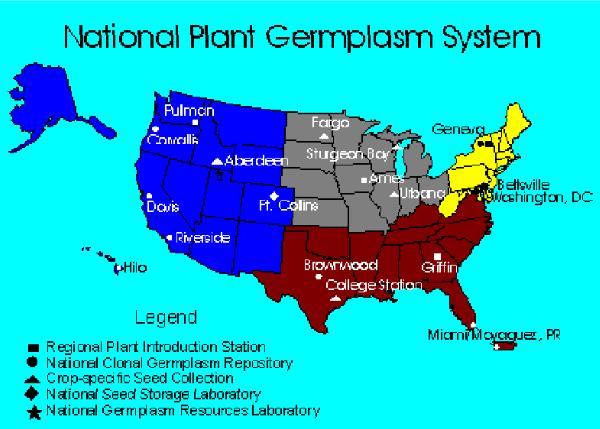
The NSSL is a facility of the USDA National Plant Germplasm System, which has several other, smaller storage centers around the nation that are pictured on the map above. The dual mission of the NSSL is to preserve the genetic diversity of plants around the world by storing germplasm and releasing it to breeders, farmers and researchers, and to conduct ongoing research on storage methods for seed, pollen and shoot-tips. The laboratory also investigates seed germination issues as they relate to stored seed. Preservation of germplasm will become increasingly critical as the world's plant diversity continues to decline under the pressures of population growth and development.
The NSSL building itself went through renovation in 1992 to create more space and implement the most advanced technology. It is regarded as a supremely secure site for seed storage; the walls are 12-inch concrete, the doors are vaulted, and security is tight. It was designed to protect its treasures from fire, natural disasters, vandalism and terrorism (consider the loss to the entire world if all that genetic diversity were lost in the explosion of a bomb.) The rooms of the first and second floor consist of research and germination laboratories, a liquid nitrogen storage vault, a bulk storage vault, records, holding and conference rooms. The third floor is comprised of seed cold vault storage.
The NSSL will accept any seeds from individuals, seed companies and public agencies deemed of value now or in the future, so long as they are accompanied by precise documentation. The samples must come with either a description of the variety or the breeding background involved, or with a citation of a journal that has such a description. Upon receipt, they become property of the US government and can never by completely be removed by any one person or entity. Seed quantity required for donation varies. For named varieties, 10,000 to 20,000 seeds are requested, but for unnamed genetic material, 500 or so is acceptable as an initial donation, since it is more difficult to produce those in quantity. The NSSL needs these quantities for three purposes: fulfilling seed requests, performing germination tests, and growing plants on to collect more seed. Each sample is labeled with a serial number, a genus and species number, and a germination percentage based on the Lab's own trial (the seeds must meet a minimum germination guideline.) Plant scientists can request small numbers of seed at no charge, but only when they are unavailable elsewhere.